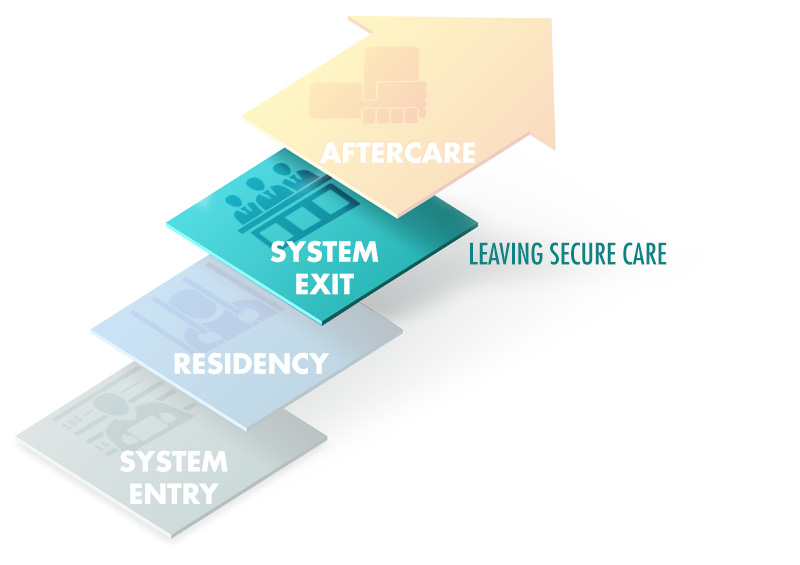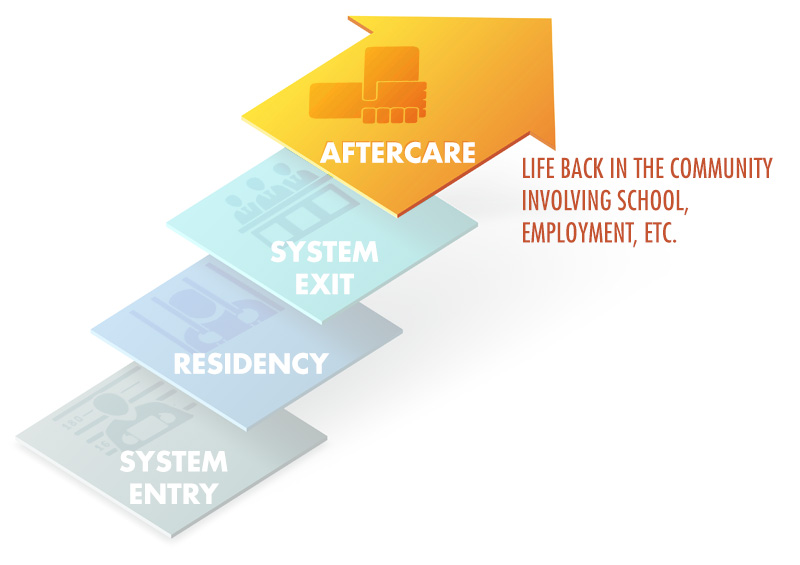How might transition planning evolve during incarceration?
Page 5: Transition Planning for System Exit and Aftercare
 As was stated previously, the recommended practice related to transition is exit at entry. Because exiting the system requires a great deal of planning and coordination to ensure that youth have the supports they need to successfully re-enter the community, effective transition planning must begin as soon as the youth enters the JC facility. In the case of youth with disabilities, to prevent them from reoffending or returning to incarceration, transition planning requires more supports than is typical for other incarcerated youth. The transition team, including the youth and his or her family or guardian, meets on a regular basis to review the transition plan and revise as necessary.
As was stated previously, the recommended practice related to transition is exit at entry. Because exiting the system requires a great deal of planning and coordination to ensure that youth have the supports they need to successfully re-enter the community, effective transition planning must begin as soon as the youth enters the JC facility. In the case of youth with disabilities, to prevent them from reoffending or returning to incarceration, transition planning requires more supports than is typical for other incarcerated youth. The transition team, including the youth and his or her family or guardian, meets on a regular basis to review the transition plan and revise as necessary.
Effective Transition Practices
On this page, we will discuss five of the six effective transition practices that are implemented at system exit.
| Create a Transition Team | Create a Transition Plan | ||
| Establish Quick Records Transfer | Utilize Evidence-Based Practices | ||
| Monitor the Transition Process |
While the youth is incarcerated, transition planning mainly addresses her or his current needs as they relate to the youth’s short- and long-term goals. As the youth’s release date approaches, the transition team should focus increasingly on identifying and putting into place the supports and resources the youth will need to successfully transition into the community, including school, employment, and home using evidence-based practices to the greatest extent possible. Additionally, the transition team should create a plan for monitoring the youth’s progress following her or his release.
Addressing Key Areas of Transition Prior to System Exit
The ways in which the areas of education, employment, and independent living skills are addressed leading up to system exit are discussed briefly below.
![]()
The youth’s educational record needs to include up-to-date information about his or her current level of educational functioning and educational goals. The cumulative record file should include the student’s current IEP, as well as work products/portfolios, high school credits earned, and courses taken while incarcerated. For youth with disabilities, it is especially important that the educational supports and accommodations the youth received while incarcerated are documented in this record. The team should try to anticipate and plan for the comprehensive needs of the youth in the community school setting so as to have appropriate supports in place upon exit from the JC setting.
Key Activities Prior to System Exit
- The transition coordinator helps the youth enroll in school or a job training program, for those wishing to continue their education. All enrollment or application procedures should be in progress or completed by the time the youth leaves the JC facility, so that he or she can make a smooth transition to the school or job training program he or she will attend.
- The transition team identifies any additional supports the youth might need in order to graduate, such as tutoring, study skills, or homework completion assistance and includes them in the transition plan.
- The transition coordinator arranges for the speedy transfer of records between the JC facility, the school, and other relevant agencies.
For Your Information
To help make the transition as smooth as possible, it is beneficial for the receiving school to allow the youth to visit prior to release to familiarize or re-familiarize him or herself with the environment. Further, the receiving school can hold an IEP meeting before the youth returns to address any needed changes to the IEP.
![]()
The transition plan needs to describe the services and supports the youth requires to find and keep a good job on reentry. Any skills or certificates of completion (e.g., mechanical drafting, appliance repair) that the youth has earned are included in his or her file so that prospective employers can be aware of what training he or she has received.
Key Activities Prior to System Exit
- The transition team helps the youth complete job applications and arrange job interviews.
- The transition team helps the youth find job training opportunities (e.g., auto mechanic training, cosmetology school).
- The transition team helps the youth to connect with peer supports or mentors who can help him or her to remain employed.
- The transition team arranges pre-release visits to job sites, apprenticeships, or job-shadowing opportunities.
Deanne Unruh discusses some of the considerations for preparing youth for employment once they are released (time: 2:16).

Deanne Unruh, PhD
Principal Investigator, STAY OUT
Co-Director, National Technical Assistance Center on Transition
Associate Research Professor
University of Oregon
Transcript: Deanne Unruh, PhD
Employment for young offenders with disabilities serves as a protective factor for these youth. So it’s very important to ensure that they’re prepared to enter the workforce.
We were asking entry level employers their impressions of working with young offenders in the juvenile justice system, and it was really interesting that employers were really split. There were some employers that basically said if they’re performing on the job and I can train them to do what I want, and they show up on time and are respectful, I could really care less if they’ve been involved in the juvenile justice system. There are other employers that basically said, oh, my gosh, if he or she didn’t tell me that he had been involved in the juvenile justice system and I found out later, I would consider that lying on the job, and they said they’d fire the youth on the spot.
So we’ve developed two lessons that report this information back to the young offenders that not all employers are going to be welcoming, helping them identify the when, the what, and how much to share to an employer, but also letting them know that there may be risks involved, but there could be some benefits to their disclosure for that. Being able to roleplay these situations hopefully will help the youth transfer this skill if they have to ever use it in an employment setting.
And what we’ve found also is oftentimes a good placement for youth with disabilities working in the community are more of the small mom-and-pop stores or services. Oftentimes, these jobs offer the opportunity that there may develop a strong mentorship or sort of an apprentice for the young offender. It might also offer a positive adult role model for the individual. The boss or supervisor may have been in trouble themselves in their youth, or they may have had a son or daughter that was involved with the juvenile justice system, and they want to make sure that other youth may not have to go down the path that they did or their daughter or relative did. And so they can serve as a positive role model and support the youth in their employment opportunities.
![]()
At the youth’s time of exit, the transition plan will need to include the community supports and services necessary to help him or her to live and participate fully in the community. These can include mental health services, support groups, transportation services, and community activities (e.g., recreation, volunteer, faith-based).
Key Activities Prior to System Exit
- The transition team encourages and aids the youth in finding a mentor and or a peer support group to maintain a successful transition.
- The transition team arranges for youth to participate in intervention or counseling programs in the community that address mental health needs (e.g., arrange for counseling sessions), independent living skills (e.g., creating a budget), and other necessary skills (e.g., parenting).
- The transition team helps facilitate the youth’s participation in community activities.
- The transition coordinator helps the youth’s family to prepare for his or her return home (e.g., by establishing realistic expectations, by appropriately monitoring the youth’s activities).
For Your Information
The transition back home can be difficult for both the family and the youth. Family counseling or therapy might prove helpful to both parties to help smooth the transition. It might also be beneficial if the youth returns home gradually on furlough, starting with short visits (e.g., two hours) and incrementally moving toward longer ones.
Aftercare
 Once the youth is released from the JC setting, all the community supports and services described in the transition plan should be implemented. Because most youth remain under the jurisdiction of the juvenile justice system for some period following their release (typically 6 to 12 months), they can continue to communicate with the transition coordinator and transition team to receive assistance in addressing any difficulties should they arise. The goal is for the youth to establish and maintain a successful transition back to the community setting. Some key activities include:
Once the youth is released from the JC setting, all the community supports and services described in the transition plan should be implemented. Because most youth remain under the jurisdiction of the juvenile justice system for some period following their release (typically 6 to 12 months), they can continue to communicate with the transition coordinator and transition team to receive assistance in addressing any difficulties should they arise. The goal is for the youth to establish and maintain a successful transition back to the community setting. Some key activities include:
- The transition coordinator monitors the youth’s activities (e.g., school attendance, work performance, home and community engagement) following release.
- The transition coordinator and transition team provide assistance (e.g., additional counseling) when difficulties arise.
Leslie LaCroix describes how transitioning planning becomes more intensive prior to release and how youth are monitored during aftercare. Some of the details she mentions may be unique to the facility in which she works (time: 1:47).

Leslie LaCroix, MAT
Transition Specialist, Project RISE
Mary Lou Fulton Teachers College
Arizona State University
Transcript: Leslie LaCroix, MAT
About a month before they leave, the services ramp up. In that month, we can line up interviews, be sure that the child has appropriate clothes to go to interviews, that the resume is as beautiful as it can be, that we have a copy of the unofficial transcript from the school, that maybe some of our community partners may be willing to interview the child or allow them to go and job shadow for a day. We have lots of kids who are interested in auto mechanics, for example, and we have community partners who own auto places. So we try to partner them up.
We make sure that their transportation needs are met if they need bus passes, light-rail passes, whatever it is that’s going to help them get around. There’s a parole plan for every youth who leaves prior to 18. The parole plan is a legally binding contract that the youth signs, and there are a whole bunch of categories on it, education, work. Every youth on parole is required to do weekly drug testing and communication with the PO, so you can’t leave the state. When they’re first released, there’s pretty heavy monitoring. It’s weekly that they check in. Between the parole officer and the transition specialist, they make sure that the child is enrolled in school or help them find a job. What we do is, we say if Johnny does not show up for work, here’s my phone number. Please call me. We do this with education also. It’s not just employers. If Johnny doesn’t come to school, please call me, and I will find out why, and I will make sure that he gets there.
Carlos
 As Carlos approaches his exit date, the Maple Hill staff, in cooperation with the receiving school, schedule a couple of days during which Carlos will visit his new school. During the first such visit, he takes part in an IEP meeting, which includes members from Maple Hill, as well as from the receiving school. The IEP team revises his individualized transition plan to address coursework and work-based learning experiences. As part of Carlos’ ITP, the team will arrange for him to shadow the school computer technician one period a week during his study hall. They will also set up a part-time afterschool apprenticeship with a local computer repair shop where he will work eight hours per week. The team feels that this will also give Carlos a positive and productive outlet after school. On his next visit, he meets with the counselor and sets up his course schedule and discusses extracurricular activities.
As Carlos approaches his exit date, the Maple Hill staff, in cooperation with the receiving school, schedule a couple of days during which Carlos will visit his new school. During the first such visit, he takes part in an IEP meeting, which includes members from Maple Hill, as well as from the receiving school. The IEP team revises his individualized transition plan to address coursework and work-based learning experiences. As part of Carlos’ ITP, the team will arrange for him to shadow the school computer technician one period a week during his study hall. They will also set up a part-time afterschool apprenticeship with a local computer repair shop where he will work eight hours per week. The team feels that this will also give Carlos a positive and productive outlet after school. On his next visit, he meets with the counselor and sets up his course schedule and discusses extracurricular activities.
Also in preparation for system exit, members of the transition team at Maple Hill meet to plan other details of Carlos’ release. They arrange for him to stay with his grandmother, who has been a stable and positive influence in his life. He will continue family counseling with his father through a community agency and will have weekly supervised visits. Additionally, the team will find a mentor who can meet with Carlos at least once a week and be available to support him when needed. At this meeting, Carlos’ parole officer provides details on what to expect as part of his aftercare programming once he is released.
Click here to review Carlos’ transition plan.
Note: For the purposes of this example, the plan only addresses Carlos’ transition from a JC setting into the community. As a student with a disability, Carlos would also have a secondary transition plan which would address additional aspects of his transition, which we do not include here. For more information about the secondary transition process for students with disabilities, please visit the IRIS Modules: